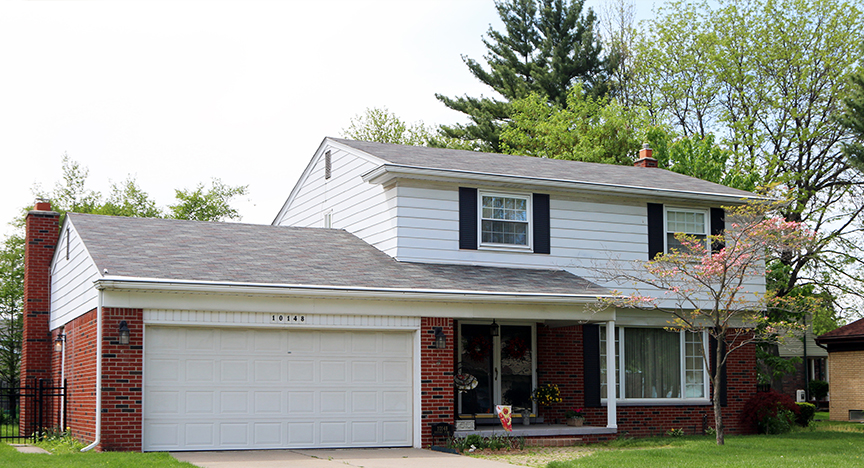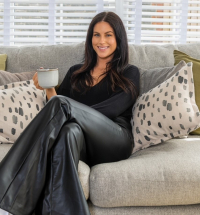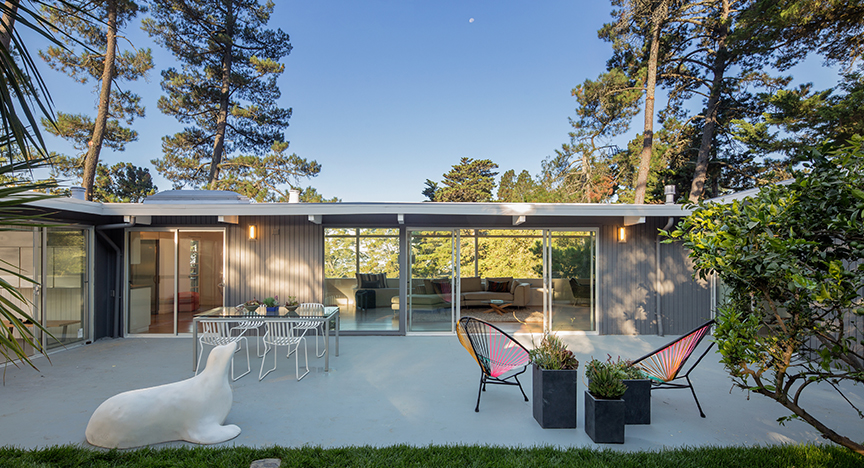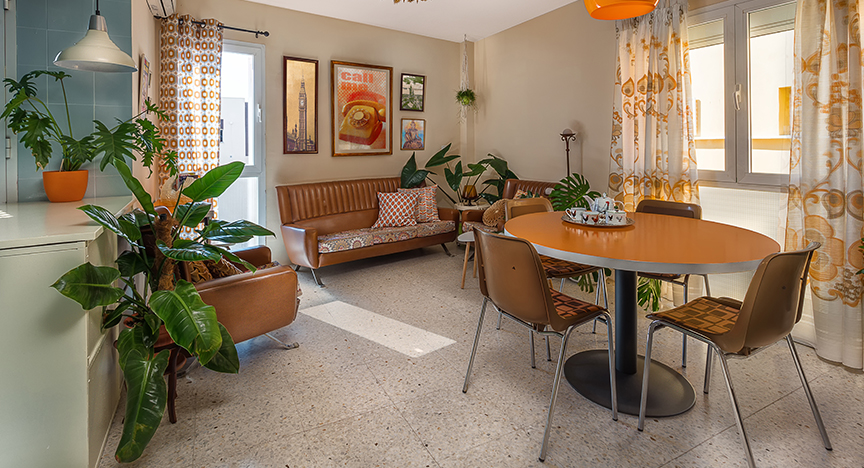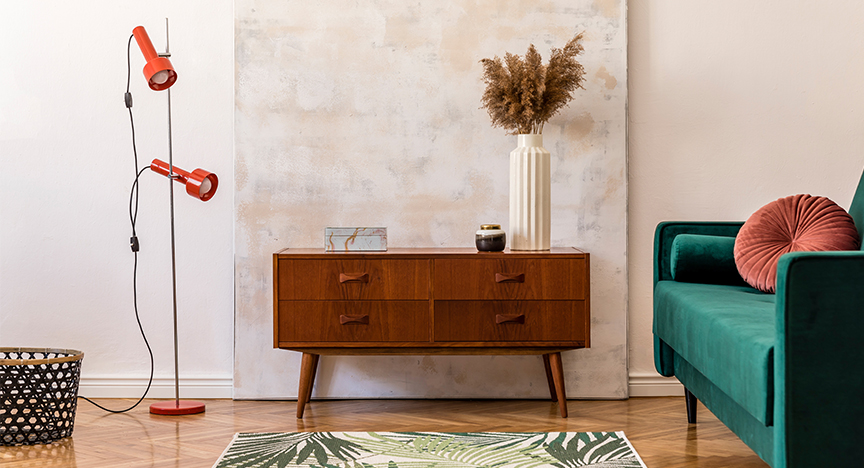The 1960s was a decade of radical change and cultural revolution, and nowhere was this more evident than in interior design. From the vibrant colours and bold patterns of mod style to the sleek lines and futuristic motifs of space-age design, the 1960s ushered in a new era of creativity and innovation in home decor.
To get your creativity flowing, this guide explores the top interior design trends from the 1960s to inspire your next home decor project. From the influence of pop art to the rise of psychedelic aesthetics, there's much to discover in this iconic decade of design.
What influenced interior design trends in the 1960s?
The Mod movement
The Mod movement, with its emphasis on youth culture and modernity, had a profound influence on interior design in the 1960s. It began in London in the 1950s and spread throughout the country, shaping music, fashions and social values in its wake.
Trademarks of mod style include tailor-made suits, scooters (the iconic Lambretta and Vespa), and the pursuit of European aesthetics, all of which could be seen throughout the boutique stores of London’s most prominent shopping streets.
Bring a bit of Mod energy into your 21st-century home by choosing accessories and furnishings that echo the clean, sharp lines seen everywhere in this period. Roller blinds in block colours, especially the white, red and blue of the Mod icon, are ideal.
Pop art and bold graphics
The emergence of pop art in the 1960s had a significant impact on interior design, with bold graphics and vibrant colours becoming key features of the era's decor. Inspired by the work of artists like Andy Warhol and Roy Lichtenstein, homeowners embraced pop art-inspired motifs such as comic book prints, oversized polka dots, and psychedelic swirls in their home decor.
From pop art posters to statement-making patterned blinds, bold graphics added a sense of fun and playfulness to interiors, creating visually dynamic spaces that reflected the spirit of the times.
The space-age
The space race between the USA and Russia fueled a global fascination with space-age design, characterised by sleek lines, futuristic shapes, and metallic finishes. Inspired by the promise of space exploration and scientific progress, homeowners embraced space-age aesthetics in their interiors, incorporating elements such as lava lamps, pod chairs, and shiny chrome accents.
Easy ways to blast your home’s interior decor off into space-age awesomeness include installing metal Venetian blinds, metal fixtures and shiny accessories throughout a room.
The psychedelic movement
The totally trippy psychedelic movement of the 1960s brought a burst of colour and creativity to interior design, with swirling patterns, vibrant hues, and mind-bending motifs becoming hallmarks of the era's decor.
Influenced by the music and art of the counterculture movement, psychedelic design embraced a sense of freedom and self-expression, transforming interiors into kaleidoscopic wonderland.
From psychedelic wallpaper to tie-dye textiles, psychedelic design elements added a sense of whimsy and surrealism to interiors, creating immersive spaces that invited exploration and discovery.
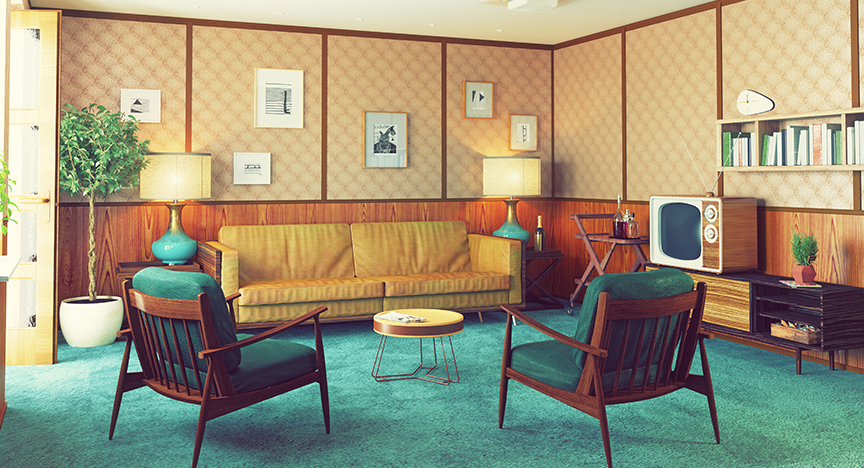

The top interior design trends from the 1960s
Modernist minimalism
At the heart of 1960s interior design was a focus on modernist minimalism, characterised by clean lines, open spaces, and a pared-back aesthetic. Influenced by the principles of Bauhaus design and Scandinavian minimalism, modernist interiors embraced simplicity and functionality, creating serene and uncluttered spaces that celebrated the beauty of form and function.
From sleek modular furniture to minimalist decor accessories, modernist minimalism offered a timeless and elegant approach to interior design that continues to resonate with homeowners today.
To achieve this in your own living room or bedroom, look to include sleek, clean lines in any furnishings. Roller blinds or Roman blinds work perfectly in this respect, holding a simple shape that adds definition to your space.
Pop art explosion
Pop Art exploded onto the scene in the 1960s, injecting homes with a dose of boldness, humour, and irreverence. Inspired by popular culture and consumerism, this art movement celebrated the ordinary and turned everyday objects into vibrant works of art.
In a 1960s Pop Art-inspired living room, walls might be adorned with colourful prints or oversized canvases featuring comic book characters or Campbell's soup cans. Furniture and decor embraced bold colours and graphic patterns, adding a sense of fun and whimsy to the space.
Channel Pop Art vibes in your home by choosing blinds or curtains in block colours. Take inspiration from the works of Andy Warhol, picking prominent shades from his iconic pieces.
Psychedelic patterns
Psychedelic patterns were everywhere in 1960s interior design, from wallpaper to upholstery to rugs. Bold colours, swirling motifs, and optical illusions created immersive and dynamic spaces that reflected the spirit of the psychedelic movement.
Explore geometric blinds or patterned curtains to bring a dash of psychedelia into your home’s interior.
Plastic is fantastic
The 1960s witnessed the rise of moulded plastic as a revolutionary material in furniture design. From chairs to tables, designers embraced the versatility and affordability of plastic, pushing the boundaries of form and function.
Iconic pieces like the Panton Chair by Verner Panton exemplified the era's love affair with plastic with its curved, futuristic silhouette. Moulded plastic furniture brought a sense of playfulness and modernity to interiors while also reflecting the era's obsession with new technologies and materials.
Embrace the moulded plastic aesthetic by choosing faux wood blinds, which are made using premium PVC for durability and long-lasting elegance.
1960s interior design trends by room
Living rooms
- Space Age chic: Retro Futurism took centre stage in 1960s living rooms, with sleek furniture, metallic accents, and futuristic shapes creating a vision of homes in orbit.
- Mid-century modernism: Embrace the timeless appeal of mid-century modernism with iconic furniture pieces, clean lines, and a connection to nature through natural materials.
- Psychedelic patterns: Infuse your living room with the energy and whimsy of the psychedelic movement with bold patterns, vibrant colours, and textured shag carpets.
Kitchens
- Fantastic with plastic: Incorporate moulded plastic chairs or accessories into your kitchen design for a touch of '60s modernity.
- Colourful appliances: Embrace the vibrant hues of the era with colourful appliances like refrigerators or stoves in bold shades of red, yellow, or turquoise.
- Pop Art accents: Add a playful touch to your kitchen with Pop Art-inspired accessories like colourful dinnerware or whimsical wall art featuring iconic imagery from the era.
Bedrooms
- Futuristic furnishings: Create a bedroom straight out of the Space Age with sleek, futuristic furniture designs and metallic accents, such as metal Venetian blinds.
- Bold patterns: Embrace the spirit of the '60s with bold, psychedelic patterns on bedding, curtains, or window dressings.
- Mod lighting: Illuminate your bedroom with mod-inspired lighting fixtures featuring geometric shapes or funky designs.
Dining rooms
- Eames dining chairs: Incorporate iconic Eames dining chairs into your dining room for a touch of mid-century modern elegance.
- Pop Art walls and windows: Hang Pop Art-inspired pieces on your dining room walls, such as the iconic Campbell’s Tomato Soup or Banana masterpieces by Warhol. Echo these with bold block colours on your windows and doors, choosing red blinds or blue curtains.
- Futuristic lighting: Make a statement with futuristic lighting fixtures above the dining table, featuring sleek metallic finishes and geometric shapes.
Blinds and curtains for 1960s-inspired house interiors
When it comes to blinds and curtains in a 1960s-inspired home, consider options that embody the era’s psychedelic charm while providing you with the light control and privacy you need.
- Roller blinds: Opt for roller blinds in bold colours to echo the Pop Art aesthetic of the era.
- Metal Venetian blinds: Embrace the Space Age trend with metal Venetian blinds. Complement these with metal accents elsewhere in the home, such as fixtures and fittings.
- Plastic blinds: Plastic was all the rage in the 1960s, so don’t shy away from bringing its functionality into your home. Premium PVC slatted blinds, such as our faux wood blinds, provide style, sophistication and practicality.

